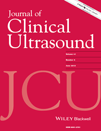Evaluation of left anterior descending coronary artery stenosis severity from myocardial end-diastolic wall stress estimated by tissue-Doppler imaging
ABSTRACT
Purpose
To identify patients with significant coronary artery disease by the noninvasive quantification of myocardial wall stress in diastole.
Methods
We studied 60 male subjects in sinus rhythm with significant (n = 30) or moderate (n = 30) proximal left anterior descending coronary artery stenosis, and 30 healthy subjects (control group). The average end-diastolic wall stress was estimated at left ventricle anterior and interventricular septum wall segments from regional wall thickness, meridional and circumferential regional radii of curvature, and noninvasively estimated left ventricular end-diastolic pressure.
Results
There were significant differences in left ventricular end-diastolic pressure between patients and controls (p < 0.05). End-diastolic myocardial wall stress was significantly different between patients with significant and moderate coronary stenosis and healthy subjects in all anterior and septal wall segments (p < 0.05) except for the anterior wall at mid level. The receiver-operating characteristic curves showed that septum apex wall stress has the highest discriminatory power for predicting significant stenosis versus healthy coronary artery with 83% area under the curve.
Conclusions
Estimated end-diastolic myocardial wall stress may help in evaluating regional myocardial dysfunction due to coronary artery disease. © 2013 Wiley Periodicals, Inc. J Clin Ultrasound, 41:297–304, 2013




